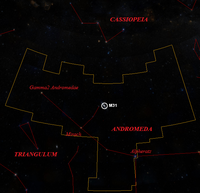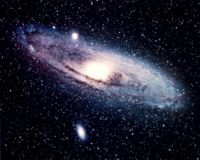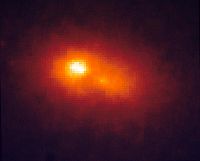Andromeda Galaxy
 From Conservapedia
From Conservapedia | Andromeda galaxy | |
|---|---|

| |
| Observational Data | |
| Designation | Messier 31 NGC 224 |
| Right ascension | 00h 42m 44.3s |
| Declination | +41° 16′ 9″ |
| Constellation | Andromeda |
| Type of object | Spiral galaxy |
| Dimensions | 190x60'[1] |
| Magnitude | Apparent Mag: +3.44[1] Absolute Mag: -21.5[1] |
| Redshift | -0.001000±0.000013[2] |
| Astrometry | |
| Distance from Earth | 2.54 million light years[1] |
| Radial velocity | −300.0±4.0 km/s[2] |
The Andromeda Galaxy, also known as M31, or NGC 224 is a large barred spiral galaxy (type Sb), the nearest of such to the Milky Way, and situated within the same galactic cluster called the Local Group. It appears to be within the constellation Andromeda, hence its name.
Located beyond the Milky Way, the Andromeda galaxy is one of the most distant objects visible to the unaided eye in the night sky. The galaxy is the largest of the Local Group with perhaps as many as one trillion stars to the Milky Way's 200-400 billion stars.[3] Once thought to be the most massive galaxy as well, more recent studies have shown our galaxy is at least as massive.[4] Unlike most galaxies, Andromeda is moving towards us instead of receding as shown by its negative redshift.
Contents
- 1 History of Observation
- 2 Environment and Structure
- 2.1 Galactic Nucleus
- 2.2 Satellite Galaxies
- 2.3 Galactic Halo
- 3 References
History of Observation[edit]
Although most likely known for many years as a faint visible sky object, the first known recording of the Andromeda galaxy is by the Persian astronomer Abd-al-Rahman Al-Sufi in 964 A.D. is his Book of Fixed Stars. There is no mention of the galaxy again until around 1500 when it appears on a Dutch map of the stars in 1500. The galaxy was also observed and recorded by Simon Marius in 1612, which is the first known observation by telescope.[5] Charles Messier incorrectly gave credit for the discovery to Simon Marius, unaware of Al-Sufi work several centuries earlier, when he cataloged the galaxy as M31 in 1764.
The galaxy, when known as the Great Andromeda Nebula was thought to be relatively close. William Herschel incorrectly estimated in 1785 that it was no more than 2,000 times the distance of Sirius. Because astronomers were unaware of the "nebula's" true distance, when the first recorded supernova occurred in the galaxy in 1885 (called "S Andromedae"), it was thought too dim and instead simply a nova.[6]
In 1887, for the first time photographs were taken of the galaxy, revealing its spiral shape. In 1912 the "nebula" was measured by the Lowell Observatory at moving at a radial velocity of 300 km/s towards the Earth.[7]
The first person to discover the true distance and nature of Andromeda was Heber Curtis, when in 1917 he examined several previous photographs of the galaxy, finding 11 more novae, noting that they were 10 magnitudes fainter then similar novae in our own galaxy. Because of this, he became a proponent of the "island universes" hypothesis, estimating Andromeda to be 500,000 light years distant, and as a separate galaxy. The debate to whether Andromeda was another galaxy (and indeed if there were other galaxies) was conclusively settled when in 1923, when Edwin Hubble discovered the first extragalactic Cepheid variables, located within Andromeda, showing that it was not a nebulae within the Milky Way, but another distant galaxy.[8]
The distance to the galaxy was again doubled when in 1953 when a second dimmer type of Cepheid variable was discovered. This distance was further refined in the 1990s using the Hipparcos satellite to calibrate Cepheid distances using red giants and red clump stars.[9]
Environment and Structure[edit]


The Andromeda galaxy is the most studied galaxy outside our own. This is due to the fact the structure of Andromeda is so similar to that of the Milky Way as in it contains generally the same celestial features, such as a spiral structure, globular and open clusters, interstellar dust and gas, planetary nebulae, supernova remnants, and companion galaxies. Unlike our own galaxy, these features can be studies in Andromeda without nearby interstellar dust obscuring the view.
The Andromeda galaxy is wider, and more luminous then our own Milky Way. Andromeda also appears to contain far larger amount of stars, and is some 25% more luminous then are own galaxy. However our galaxy has 3 to 5 times the rate of star formation at present, as well as twice the rate of new supernovae. This suggests that Andromeda had a much greater period of star formation in the past but has since become far more quiet then our own galaxy in that arena.[10]
Although larger, the Andromeda galaxy appears to have a lower mass (300-400 billion solar masses for visible material), then our own Milky Way (at least 600 million solar masses for visible material). This would make the Andromeda galaxy significantly less dense then our own. These results are from calculated estimates of the total halo masses of the two galaxies accounting for the gravitational effects of dark matter. This suggests Andromeda has a total mass of around 700 billion to 1.2 trillion solar masses compared to 0.93 to 1.9 trillion or more for the Milky Way.[11]
One of the star clouds in Andromeda has its own NGC (New General Catalogue) number, known as NGC 206. The region is one of the largest star-forming region known in the Local Group, filled with massive, young blue stars. The region is located in the southwestern outer edge of the spiral disk. It was first noted by William Herschel and was recorded as H V.36 in his catalog in 1786.
Galactic Nucleus[edit]

In the 1990s using the Hubble Space Telescope, it was thought that Andromeda may have two galactic nuclei when it was discovered that the galactic nucleus has two "hot spots". The two nuclei appeared to be moving is respect to each other, although one is disrupting the other through tidal forces. At first it was believed that one of the galactic nuclei was from a smaller galaxy that was consumed by Andromeda at some point in the past. More recent observations using Hubble's imaging spectrograph in 2005 by a team of astronomers show though that the two two bright areas in the galactic core are actually composed of a bright, small dense disk of young blue stars within an elliptical ring of older red stars, all orbiting the supermassive black hole in the center.[12]
Much like our own galaxy, Andromeda has a supermassive central black hole located at the center of the galactic nucleus. The black hole itself has an estimated mass of 140 billion solar masses.[13] The Chandra X-Ray Observatory recently revealed other sources of x-rays within the galactic core. It is believed most of these are due to binary systems where one star is losing mass to its neutron star or black hole companion.
Satellite Galaxies[edit]
Andromeda has 14 known dwarf satellite galaxies, of which M32 and M110 are the most well known and studied. M32 may have been once a large galaxy that was striped of its stellar disk by Andromeda after a close encounter, which also seemed to have caused a large burst in star formation in the dwarf galaxy until the recent cosmological past.[14] M110 also appears to be interacting with the Andromeda galaxy, this is due to metal-rich stars being located in the normally very metal-poor region of Andromeda's halo.[15] M110 is also appearing to be undergoing elevated star formation.[16]
In 2006 it was discovered that nine of Andromeda's 14 satellite galaxies all lie within a thin sheet that runs perpendicular through Andromeda galactic disk and core and is almost perfectly aligned with the galaxy's polar axis. The sheet runs through Andromeda's core and is almost exactly aligned with its polar axis. This may indicate a single common tidal origin for these galaxies, such as left-overs of a breakup of a much more massive galaxy.[17]
Galactic Halo[edit]
Andromeda's halo is thought to be significantly larger and more diverse then that of the Milky Way. In 2003, using the Hubble Space Telescope, astronomers took the deepest visible light image of the night sky up to that time, pointing in the direction of Andromeda's halo. Some 300,000 stars in the halo were resolved and studied, and using the images, astronomers were able to estimate the ages of the various stars through an analysis of the distribution of their color and brightness.
Further research of the halo in 2007 found that several metal-poor red giants stars are orbiting at a substantial distance as part of the galactic halo, making Andromeda's total size possibly much larger than originally estimated.[18]
Recently, a stream of younger, metal-rich stars have also been located in the galactic halo. The presence of these stars seem to indicate the collision of the Andromeda galaxy with smaller galaxies that since have been absorbed.[19]
References[edit]
- ↑ 1.0 1.1 1.2 1.3 [1]
- ↑ 2.0 2.1 M31 from simbad.u-strasbg.fr
- ↑ http://www.newscientist.com/article/dn9282-andromeda-galaxy-hosts-a-trillion-stars.html
- ↑ http://www.cfa.harvard.edu/news/2009/pr200903.html
- ↑ http://penelope.uchicago.edu/Thayer/E/Gazetteer/Topics/astronomy/_Texts/secondary/ALLSTA/Andromeda*.html
- ↑ http://adsabs.harvard.edu//abs/1888MNRAS..48..108B
- ↑ http://www.seds.org/messier/m/m031.html
- ↑ http://adsabs.harvard.edu/abs/1929ApJ....69..103H
- ↑ https://arxiv.org/abs/astro-ph/?9802121
- ↑ http://www.springerlink.com/content/1x7ebfnhu9mm6wqd/
- ↑ https://arxiv.org/abs/0801.1232
- ↑ http://hubblesite.org/newscenter/archive/releases/2005/26
- ↑ http://hubblesite.org/newscenter/archive/releases/2005/26/full/
- ↑ http://adsabs.harvard.edu/abs/2001ApJ...557L..39B
- ↑ http://www.nature.com/nature/journal/v412/n6842/abs/412049a0.html
- ↑ http://www.iop.org/EJ/abstract/1538-3881/120/5/2460
- ↑ http://adsabs.harvard.edu/abs/2005astro.ph..9258K
- ↑ http://news.bbc.co.uk/2/hi/science/nature/6240611.stm
- ↑ http://adsabs.harvard.edu/cgi-bin/bib_query?2001Natur.412...49I
| |||||||||||||||||
Categories: [Astronomy] [Galaxies] [Messier Objects]
↧ Download as ZWI file | Last modified: 03/01/2023 09:34:06 | 16 views
☰ Source: https://www.conservapedia.com/Andromeda_galaxy | License: CC BY-SA 3.0
 ZWI signed:
ZWI signed: KSF
KSF